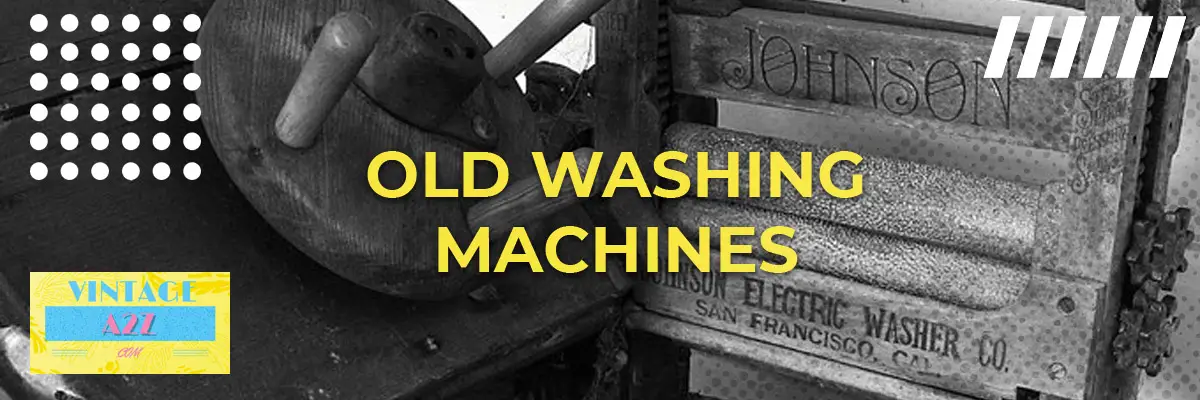Have you ever wondered how people used to clean their dirty clothes before washing machines were invented?
Before the invention of antique washing machines, dirty clothes were cleaned by rubbing them with abrasive sands or pounding them on the rocks. Evidence of the washing soap the people of ancient Rome used to clean clothes was discovered at Sapo Hill, Rome. Strangely enough, the used the ashes of sacrificed animals as a type of soap.
It wasn’t until the 1700s that the first washing “machine” was invented. The birth of the vintage washing machine dates back to the 1700s when people were looking for the best ways to clean their clothes. Initially, it all started in water streams and later in more sophisticated tanks and water-houses.
The invention of the oldest mechanical washing machine
The oldest mechanical washing machine resembled a scrub board. It looked nothing like the washing machines we have today. The antique washing machine prototype was built by Jacob Christian Schäffer in 1767, but then upgraded in 1851 to add a hand-operated turner and a drum.
The invention of this machine allowed women to quit pounding dirty laundry on rocks and gave the possibility for sea voyagers to clean their dirty laundry, rather than tossing it overboard!
Schäffer, a jack-of-all-trades, held degrees in Philosophy and theology and was also a member of many academic societies.
What inspired Jacob Schäffer was a magazine article about a Danish version of the English washing machine called the “Yorkshire Maiden.” In 1767, he announced his improved version of the washing machine, explaining its advantages in a book and detailing his different experiments with cleaning different types of clothing.
He concluded the main advantages of the washing machine were:
- The washerwomen needed not to fear losing much income.
- Better health was guaranteed if the washerwomen could stay dry in cold weather, especially when working.
- His washer would save on heating fuel, lye, and soap.
Schäffer oversaw the construction of sixty of the oldest washing machines of this type, and the make was successful enough that is was manufactured for another century in Germany (of course with slight adaptations).
The issuing of the first patent for the oldest machines’ rotating drum was issued in 1782 by Henry Sidgier.
30 years after the oldest washing machine was built by Schäffer, a drum washing machine was built to facilitate the washing of clothes. In that very year, Nathaniel Briggs a New Hampshire inventor, was awarded the first patent with the title “clothes washing.”
The oldest washing machine according to historians
The title of “washing machine inventor,” according to historians, doesn’t belong to German Schäffer, but rather to an American named William Blackstone. He made his wife a wooden barrel in 1874 as a birthday present, which contained laundry soaked in soapy water. An axle equipped with different pegs was moved around by hand.
This vintage washing machine was the very first official washer to be used at home. Although it may seem basic, this antique allowed women to clean their dirty clothes with much more ease than before its invention.
For this reason, this vintage washing machine went on sale making William Blackstone the world’s first manufacturer of washing machines.
Frequently Asked Questions
When was the first automatic washing machine built?
Avco’s subsidiary known as Bendix home appliances was the first to introduce the domestic automatic washer in 1937 and filed for a patent in that same year. Most of the earliest automatic washing machines were installed in laundry rooms and were coin-in-the-slot models.
What was the first electric-powered washing machine?
In 1908, the mighty “Thor” was introduced by the Hurley machine of Chicago, Illinois. It was the earliest electric-powered washing machine ever manufactured and the first-ever washer sold commercially in the US. The Thor washer was a drum type with an electric motor and a galvanized tub.
Thor washing machines were not only built to save human labor, but also to save energy because the user did not have to move the laundry between circles.
What’s the oldest “modern” washing machines?
In the mid-1800s, right in the midst of the industrial revolution, the United States experienced an increase in the urban population and the working class emerged with more buying power and unlimited enthusiasm for work-saving devices.
Two Americans, James King in 1851 and Hamilton Smith in 1858, filed and got patents for devices that were similar to what historians recognize as the earliest true “modern” washing machines.
Shaker community members in Pennsylvania began making improvements on the washers’ basic technology ideas in the 1850s. They started to design and market big wooden washers built to operate on a small commercial scale.
What improvements were made to washing machines over the years?
The earliest washers had a bulky, stained, and cast-iron mounted inside the tub lid. The introduction of reduction gears and metal tubs to replace this heavy apparatus was a major improvement. The manufacture of the coppered wooden tub stopped by 1920.
From the 1920s, angle-iron legs and the copper tub were replaced by white enameled steel. By the start of the 1940s, white enameled sheet metal was used and marketed as longer-lasting, easier to clean, and being more sanitary than all the other finishes. Also, a sheet-metal skirt was built to stretch below the motor mount level.
The next upgrade of the antique washing machine was the clock timing device installation, which allowed the washer’s cycle length to be pre-determined before setting it to operate.
Washing machines made life easier for women
Before the creation of washing machines, the most tedious task of housekeeping was washing dirty clothes. It was time consuming, difficult and the lye they uses caused burns to the arms of the women washing clothes.
The earliest washing machines greatly affected the work process of cleaning dirty laundry, which was viewed by society as a woman’s task. The antique washing machine is credited as the force behind the betterment of positions of women in society. Some say the introduction of the washing machine played a great role in women’s liberation, along with contraceptive pills and reproductive rights.

